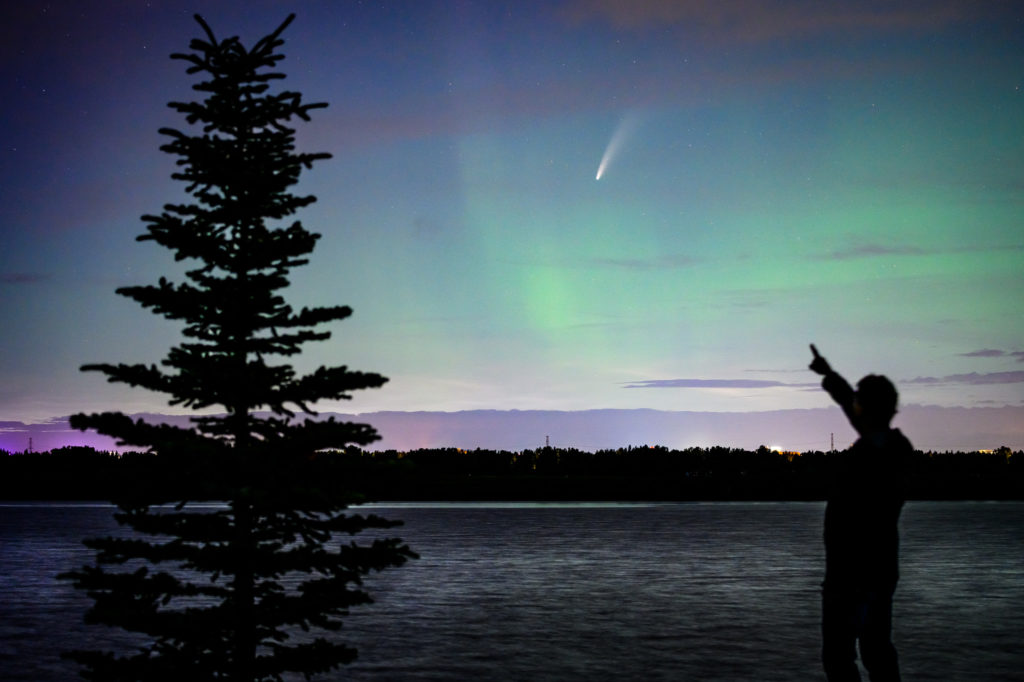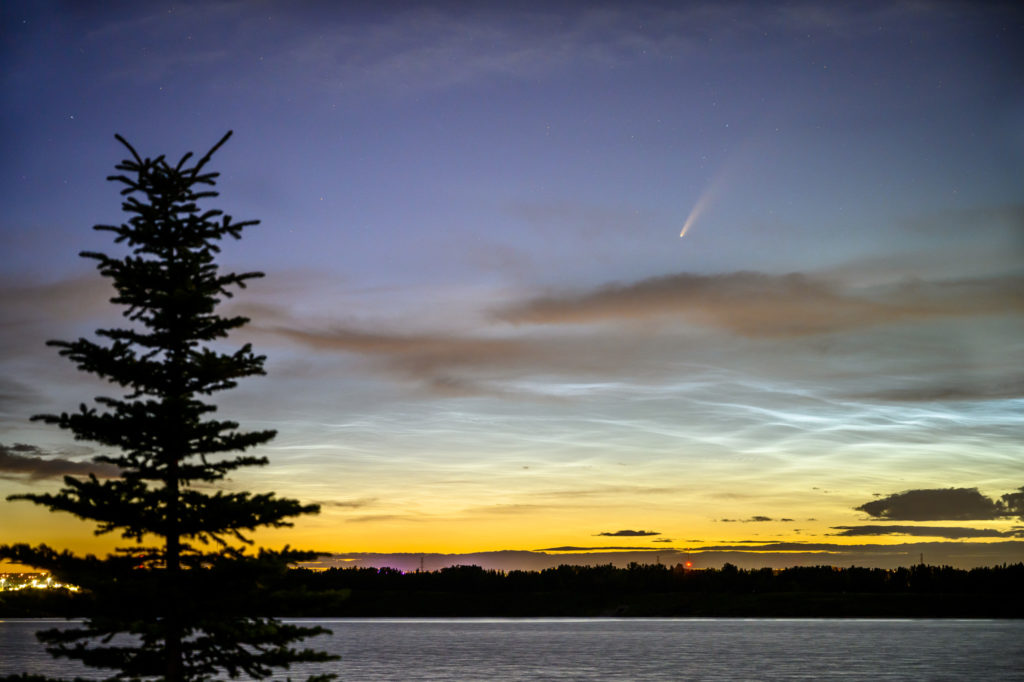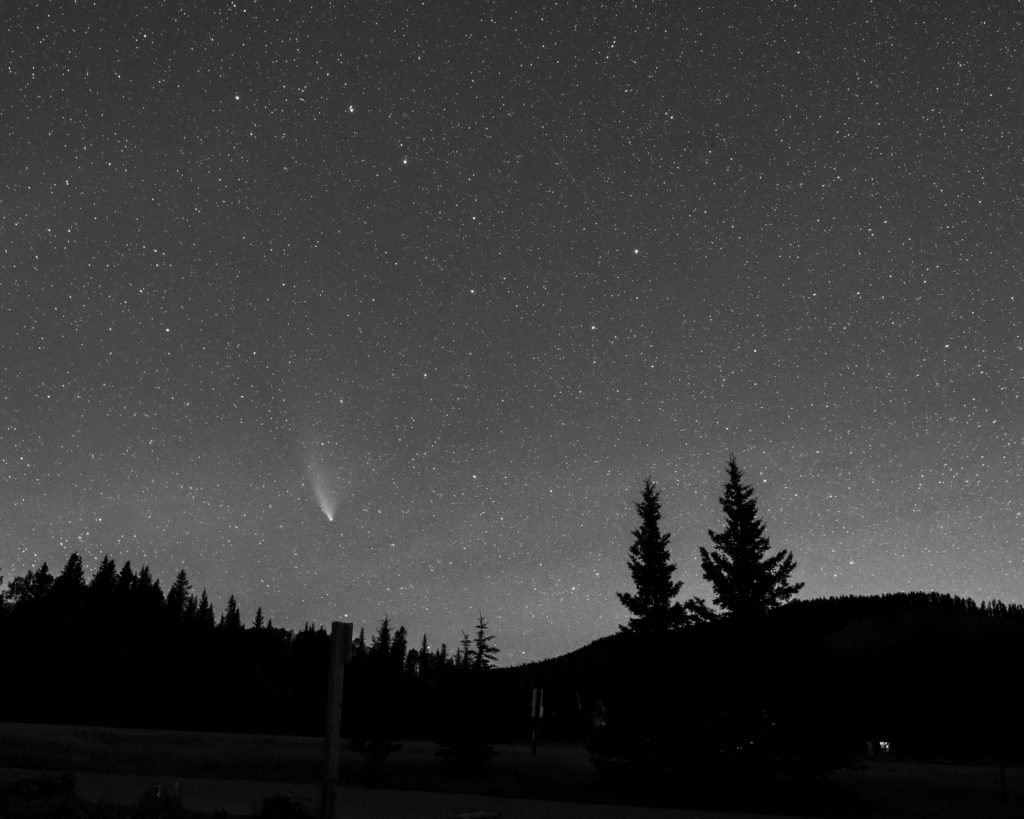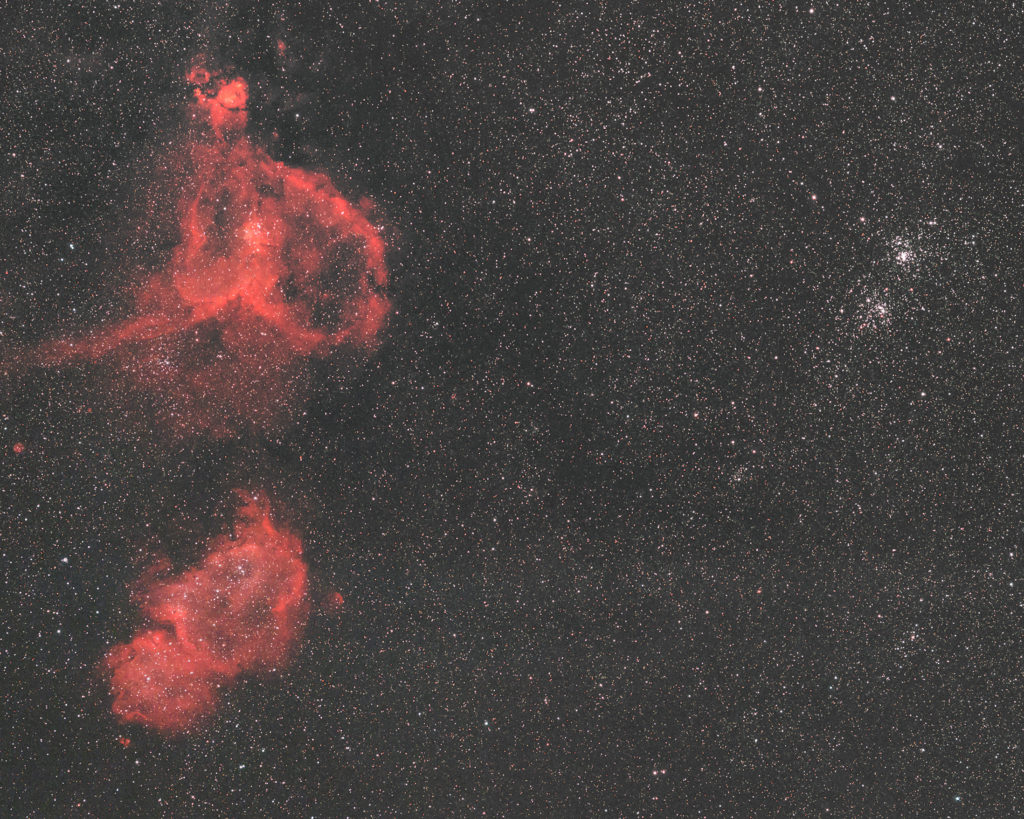
To call me an astrophotographer would be an overstatement. But that doesn’t stop me from bringing a camera along when stargazing on a clear night to complement some casual visual observations. No image can reproduce what it’s like to look through a telescope or binoculars, especially in dark sky when the eye beholds the scintillation of stars and silver-white nebulae and galaxies against the black matte of the background universe. But images have the advantage of permanence, to some degree at least, and of leaving a record of what we’ve seen and where we’ve been in the night sky over the months and years.
Imaging the night sky isn’t for the impatient or faint of heart. It can take minutes or hours of capture time and post processing to get a single ‘keeper’ astrophoto. And such work often requires looking at screens rather than the sky itself, surely a detraction for those like me who already spend too much time staring at screens.
But there are some beautiful sights up there worthy of capture, some more or less unchanging over a human lifetime and some far more transitory. During this past year I managed to capture both types of sights. Here are five of my own favorite images from an otherwise ghastly year that for most of us yielded too much free time, but also a deep need to see and make something beautiful, however modest.
Image 1 – Supernova in the Galaxy M61

This image from last May shows the supernova SN2020jfo in the galaxy M61 at a brightness of magnitude 14.5 not long after it was discovered by the Zwicky Transient Facility at the Palomar Observatory on May 6, 2020. It’s the third supernova discovered in this beautiful barred face-on spiral galaxy in the past dozen years.
More of a snapshot than a ‘real’ astrophoto, this simple mononchrome image captured with my Tele Vue 85mm refractor is a testament to the sensitivity of modern astronomy cameras. The supernova isn’t even the faintest object in the frame – 16th magnitude galaxies are stars are easily visible. Not bad for an 85mm telescope!
NOTE: Over the coming year I’ll be sharing some tutorials on this website about this type of ‘snapshot’ astrophotography, a process that yields a respectable astro-image in a matter of seconds or minutes rather than hours. More in the coming weeks…
Image Particulars
Date: May 14, 2020
Location: Calgary, Canada
Telescope: TV-85 refractor, TRF-2008 0.8x focal reducer (FL=480mm, f/5.6)
Mount: Sky-Watcher AZ-EQ5 in equatorial mode, unguided
Camera: ZWO ASI290MM monochrome CMOS camera
Exposure: 20x10s stack, dark frame applied, Gain=350
Image 2 – Comet C/2020 F3 (NEOWISE) and Noctilucent Clouds

Among the few bright spots of 2020 was the arrival of the moderately spectacular comet C/2020 F3 NEOWISE, a welcome sight after a 23-year cometary drought for northern-hemisphere observers.
Observational astronomy isn’t exactly a popular pastime, and I often joke that during even well-publicized astronomical events I can be assured that I’ll be the only person out in the local park with a telescope. But NEOWISE was different. Dozens of onlookers emerged from their homes to arrive in the local park late at night, all of them eager to see something new and beautiful and well beyond the confines and control of our benighted planet.
On the night of July 13-14, a few days after the comet made its closest approach to the sun, I grabbed camera and tripod head to a nearby park to snap an image of this visitor from the Oort Cloud. It was plenty bright: I could see it over the lights of the city through the windshield of the car as I pulled into the parking lot. Low-lying clouds intermittently blocked the view. But much higher and spectacular noctilucent clouds joined the show around midnight and made for this memorable image. As the noctilucent clouds faded, a small auroral display joined the show (see top image).
Image Particulars
Date: July 13-14, 2020
Location: Calgary, Canada
Camera: Nikon Z6 and Nikkor 24-70mm S f/4 lens at f/4
Exposure: 2 seconds at ISO1600
Processed in Adobe Lightroom
Image 3 – Comet C/2020 F3 (NEOWISE) Outbound

Comet NEOWISE continued to delight over much of July. But all good things must end, and sure enough the little comet slowly dimmed as the month wore on. In very dark sky, it was still visible to the unaided eye in the last days of July in the northern sky not far from the Big Dipper.
This image, rendered here in black and white, shows the little comet alone among the dim northern circumpolar stars, over a stand of coniferous trees at the foot of the Rocky Mountains, growing smaller and colder on its way back to obscurity in the outer solar system. On its present trajectory, if it remains unperturbed by the gravity of the major planets, it will return to the inner solar system in about 6,700 years.
Image Particulars
Date: July 27, 2020
Location: Kananaski Country, Alberta, Canada
Camera: Nikon Z6 and Tamron 15-30mm lens at 20mm, f/2.8
Exposure: 20 seconds at ISO3200
Processed and cropped in Adobe Lightroom
Image 4 – The Heart and Soul Nebula and Double Cluster

Stargazers in the southern part of the northern hemisphere and south of the equator get a spectacular view of the richest part of the Milky Way in the months of July through October. From my northerly latitude, it’s more of a challenge to see this part of the sky. And from my backyard, I can’t see it at all. So I content myself with the less spectacular but still target-rich northern Milky Way from Cygnus through Cepheus, Cassiopeia, and Perseus. This part of the sky contains plenty of photogenic star clusters and nebulae for imagers and visual observers alike.
Here I attempted to capture at least a dozen cataloged deep-sky sights in a single image including the showpiece objects IC1805 and IC1848 known at the Heart and Soul Nebulae, respectively. Both are emission nebulae, light-years-long clouds of gas and dust where new stars form and set aglow the clouds from which they were born.
The heart-shape of IC1805 is obvious. What a ‘soul’ looks like I cannot say, but with a little imagination IC1848 does resemble a nascent human shape. It looks like a fetus, really, but the “Heart and Fetus Nebulae” isn’t as attractive a name. And, anyway, there is already a “Fetus Nebula”, the small planetary nebula NGC7008 in northern Cygnus.
I captured this part of the sky with a ramshackle Nikon D610 DSLR camera converted to pass more of the deep-red light from hydrogen that’s emitted from such nebulae. The camera is operating well outside its design capability here, so it took a little finessing to remove unwanted artifacts to get a decent image. Along with the two ruby-red emission nebulae, this image contains the spectacular Perseus Double Cluster (upper right) and smaller clusters NGC957 and Trumpler 2 at lower right. Many smaller nebulae and star clusters fleck the Heart and Soul. More sub frames would help bring out more detail. But it’s getting cold this time of year.
The image covers a patch of sky about 10 degrees X 7 degrees.
Image Particulars
Date: November 29, 2020
Location: Calgary, Canada
Camera: Nikon D610 (full-spectrum modified)
Filter: Optolong L-Enhance (2”)
Telescope: Askar 200mm f/4 astronomical camera lens at f/4
Mount: Sky-Watcher AZ-GTi modified for equatorial operation, unguided
Exposure: 26×120 seconds at ISO1600
Stacked and processed in Deep-Sky Stacker and Adobe Photoshop
Image 5 – The North America Nebula

It’s hard to take a bad picture of the North America Nebula (NGC7000). This sprawling star-forming region was one of the first such objects photographed in the early 20th century, most notably by the patron saint of astrophotographers Edward Emerson Barnard. Located near the star Deneb in the tail of Cygnus, this large nebula can be spotted visually in inky-black sky in binoculars or a small telescope. But it’s a favorite object for new imagers and it yields increasing detail with a proportionate amount of effort, skill, and total exposure time. I prefer the Veil Nebula myself for a visual target. But this one is more fun to photograph, especially when paired as it is here with the adjacent Pelican Nebula (IC5070).
Image Particulars
Date: October 25, 2020
Location: Calgary, Canada
Camera: ZWO ASI533MC-Pro
Filter: Optolong L-Enhance (2”)
Telescope: Askar 200mm f/4 astronomical camera lens at f/4
Mount: Sky-Watcher AZ-GTi modified for equatorial operation, unguided
Exposure: 20×120 seconds at Gain=100
Stacked and processed in Deep-Sky Stacker and Adobe Photoshop